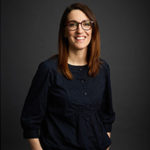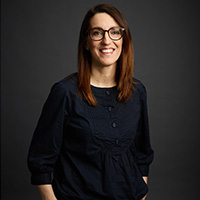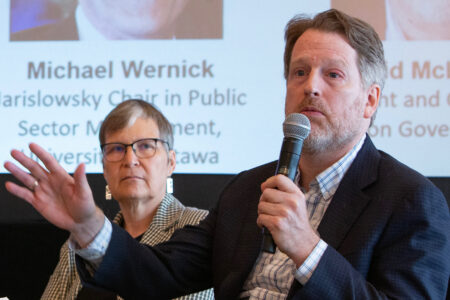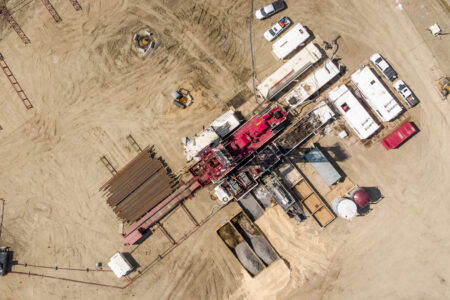
(This article has been translated into French.)
During a federal election campaign, the news agenda is often set by national media organizations such as broadcasters CBC-Radio-Canada, CTV, TVA and Global; newspapers The Globe and Mail, The National Post, The Toronto Star and La Presse; and the national news agency, The Canadian Press. But little is usually known about who makes significant editorial choices and decisions.
Often, that’s the senior news editor. Traditionally, that job encompasses multiple roles and tasks, from assigning stories to editing copy to deciding how each news item will be “played” in the newscast or newspaper, website or app. The news editor is key to preparations for a federal election, which begin at least a year in advance, with budgets allocated for travel, polling and freelance contributions. The actual planning of election stories and content starts six months prior to voting day with initial “showcase” assignments. For the Globe, these are deep profiles of the federal leaders at 5,000 words or more, formed from discussions involving senior editors from news bureaus across the country, business and features sections. Timing for publication of these stories will be determined later, as well as editing and photography – access to leaders being a key consideration.
The largest national newsrooms usually appoint a senior editor as “election overseer,” responsible for advance planning and coordination between reporters and editors focused on the campaign and those on other beats, such as business, energy or the environment who contribute specialized perspectives. Generally, an overseeing editor will be a senior manager – someone who can work with editors in all departments; assign reporters, if necessary and react nimbly to what arises during the campaign.
The establishment of fixed-date elections in Canada over a decade ago has provided news editors more time to plan their campaign-coverage strategy. Key topics and potential swing and bellwether ridings are identified; regular contributors and analysts are booked; fact-checking units, live coverage of debates, and election night itself are organized. Still, many editorial decisions are made on the fly, as unexpected events within or outside the political bubble may intervene in the campaign agenda.
Coverage is a delicate balancing act
Covering the electoral campaigns of numerous political parties is a delicate balancing act. The importance of each political party and of its leader in the overall coverage is determined by a combination of factors. Each party’s perceived strength, measured by seats in Parliament at dissolution, are assessed, as well as potential gains in the election as indicated by voting intentions and seat projections provided by polls and aggregators. Editors are attentive to shifts in public opinion as the campaign progresses, especially after the leaders’ debates and in the last few days before the vote.
Some editors decide against sending reporters on the party leaders’ campaign tours, which are expensive. In 2019, the price was $11,500 for a seat on the Conservative airplane, $27,000 for the Liberal plane and $55,000 for the NDP. Following the tours, say these editors, provides low-quality journalism with little added value for their audiences. Remaining on the ground, they say, allows for stories to be defined by citizens in different parts of the country, as opposed to allowing politicians to frame issues in daily news briefings.
Bringing to the fore issues not addressed by the parties and leaders themselves is possibly the most important contribution of media coverage during an election. A significant part of the editor’s job is to ensure the media lead the coverage and do not simply follow the priorities of parties. There is also the threat of online disinformation, a growing concern in election campaigns, in large part due to the political climate in the United States and the role of social media, especially Facebook and Google, in disseminating news. Several news organizations assign reporters to verify politicians’ statements and to debunk hoaxes, conspiracy theories or other types of false content circulating online. At mid-campaign in 2019, the volume of so-called fake news appeared to be relatively low in Canada.
Organizing resources and opportunities
Organization is a large challenge for a news editor. Reporters in the field require adequate support from their home base so assumptions and policies can be tested and questioned with up-to-date, comprehensive, and accurate information. Committing resources to in-depth profiles of leaders, for example, requires planning several months in advance to allow journalists to gain access, as well as to dig deep into the biographies of politicians, especially the party leaders.
Elections also bring business opportunities. New distribution channels can be launched, such as pop-up newsletters that bring greater exposure to content, and help to drive engagement – a key metric for most media companies. In the digital economy and especially on social media, engagement includes any type of user interaction with content: clicks, likes, shares, comments, and time spent. For publications like the Globe, which increasingly focuses on digital subscribers for revenue, free content can drive engagement, while paywall content serves to retain and attract subscribers. Senior editors rely on instinct and intuition to make decisions on subscriber-only content; for some other content, the decisions are algorithmic. Exclusive stories naturally go behind the paywall; stories that encourage a broad debate on policy may be accessed for free.
As editorial structures shrink and become more strategic, many newspapers are vying to become a subscriber business rather than focussed on obtaining revenue through advertising. To convince readers to pay for online news, they strive to offer value-added content: exclusive stories and unique insights. In this context, editors are often tasked with decisions that fall outside the field of journalism: for example, audience, metrics, revenue and marketing. Editors often play several roles, developing products and acting as project manager. They may also make a new kind of judgment call: what information is worth paying for?
Tough questions for journalists
A debate over journalistic priorities erupted during the election, concerning past actions by two political party leaders, and the implications for judging their leadership and character. Both of these examples involved stories hiding in plain sight for Canadian journalists.
The first was Justin Trudeau’s decision to wear brownface and blackface multiple times before he was an MP; and his admission during the election campaign that that was a racist act. U.S.-based Time magazine published first, social media amplified and Trudeau quickly confirmed the story. For the Globe, there was no doubt the decision of a federal leader to act in that manner was newsworthy – editorial discussions focussed instead on photos of the younger Trudeau. As it was revealed that Trudeau had worn makeup to change his skin colour three times – and perhaps more often – the decision was made: all available pictures would be published.
The story and first photo originated from a yearbook of a private school in Vancouver – something Canadian media could have readily obtained, had they been tipped off or investigated Trudeau’s time there as a teacher. It raised questions for many organizations around how much reporters really cared to dig into Trudeau’s past – it was not a Canadian journalist who discovered the photograph, but a member of the school community who released it to an American periodical.
The second case was less explosive but illustrates the kind of journalism that could have exposed the Trudeau story earlier. While Globe journalists were researching an extensive profile of Conservative leader Andrew Scheer, it became clear that one of his few professional credentials was questionable. Two reporters took several weeks to research Scheer’s past in an attempt to understand who he is. While he had spent almost his entire adult life in politics, it was unclear what experience he had outside of politics. Did Scheer really sell insurance in Saskatchewan – and, if he did, was he licensed? Ultimately, the answer was unclear, became less clear during the campaign and, eventually, became a meme used against him. The question for Globe editors was this: In a 5,000-word profile, should this information be pulled out as a standalone story? In an election defined by constant drive-by assassinations, the decision was to allow readers to absorb this detail within the context of the broader story. Other media picked up the story, however, and criticism of other aspects of Scheer’s political career brought forward by Liberals on social media, such as his prior statements on abortion and same-sex marriage, were widely covered as well.
The 2019 election is over, but significant questions remain about Canadian journalism’s insufficient research into Trudeau’s past and, more generally, the importance of investigating details of the lives of party leaders and other candidates. Meanwhile, senior news editors continue to play a significant role in defining the news of the day, despite their newsrooms’ limited resources and the fact that Canadians consume news increasingly, for free, on social media.
This article is part of The Insider’s View Behind the Scenes of Election Campaigns special feature.












